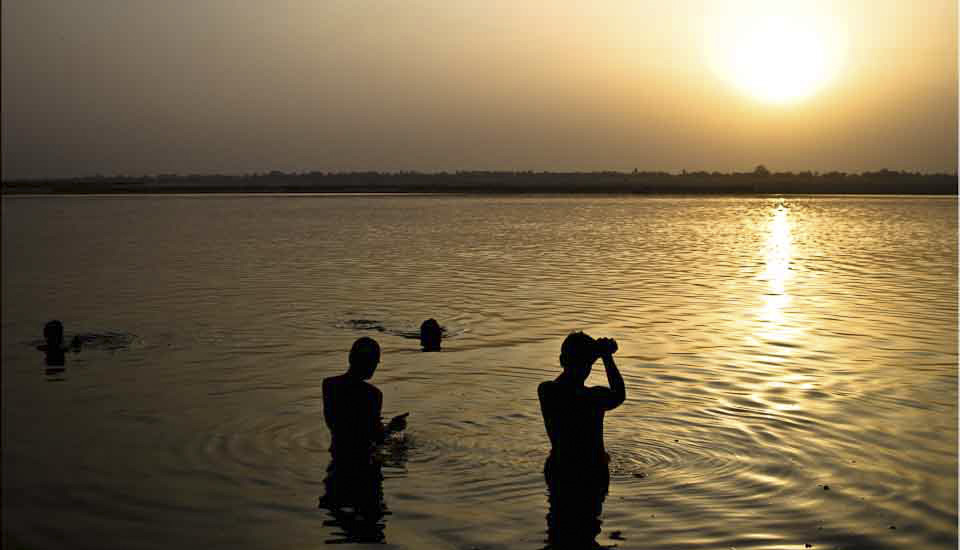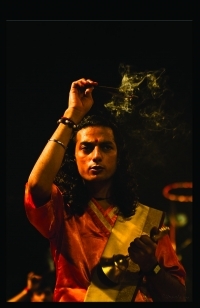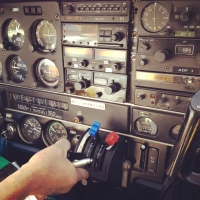.jpg)
Warrior in Feathers
The tropical rain didn’t dampen the fighting spirit of the fearsome dancers who welcomed us to the village of Mansinam in Western Papua, Indonesia.
It is remote. And rugged.
We were met with a mock war-dance: warriors sporting black body paint and carrying bamboo spears and arrows charged at us, while other villagers crowned in feathers danced and sang.
Welcome to West Papua!
The island of New Guinea has been populated for tens of thousands of years – mostly by unique, semi-isolated tribal groups of ethnic Papuans. Little was known about the eastern half of what is the world’s second-largest island until the 19th century, when it was split between German New Guinea in the north, and the British Territory of Papua in the south. Those eastern territories were later governed by Australia before becoming the Independent State of Papua New Guinea (see: Innocent Eyes and Headhunters) in 1975.
The western portion of the island, on the other hand, was visited regularly by European sailors from the late 1500s. Those merchant-sailors were searching for exotic spices – particularly nutmeg – which were only available in this region. The Dutch claimed dominance of the spice wars, and annexed the western part of New Guinea into the colony of Dutch East Indies (for a history of the Spice Wars, see: Nathaniel’s Nutmeg).
The Dutch governed the region until 1962, after which it was granted to Indonesia.
Pulau Mansinam – Mansinam Island – is a small island in Doreri Bay, just east of Manokwari City, West Papua. It marks the entry-point of Christianity into Papua. In 1855, three German-born missionaries of a Dutch Lutheran denomination, landed in Mansinam. Linguists and Bible translators, the two men – Carl Williem Ottow and Johan Gottlod Geissler – are credited with the growth of Christianity in the region. (The wife of Ottow, who was also a missionary, seems to be mostly forgotten.) They are still celebrated on the island every year on February 5th, the anniversary of their arrival.
A giant Jesus figure – which Lonely Planet calls a wannabe Rio de Janeiro statue – dominates a hill as the island’s centrepiece and a tribute to this heritage.
That very-white statue, and the newly built modern Christian church nearby, stand in bold contrast to the tribal welcome that had greeted us.
.jpg)
Morning on the Darwin Tarmac
My trip started early, with a charter Boeing 737-800 flight from Darwin, Northern Territory, Australia.
.jpg)
Flying the Flag
The ship I joined, the Coral Geographer, is registered under a Australian maritime flag.

Home for the Duration
We sail out of the Port of Sorong in West Papua, Indonesia in the afternoon …

Through the Portal
… and the next morning finds us on the Pacific Ocean above the Doberai Peninsula.

From my Room
In the waters off Manokwari Barat, I can see the sun shining over the jungled shores, beaches, and small villages at water’s edge.

The First Snorkel
Inside its protective waterproof casing, my iPhone struggled to focus on the abundant fish and corals, but I salvaged the odd shot as a record of my first underwater experience.

Warriors Welcome
Our ship docks in Mansinam, and we are treated to a traditional welcome …

Warrior in Paint
… with singers and dancers – and warriors in black paint and beads, brandishing weapons.

Girls on the Rail
I think everyone in the community has come out to watch us watching them!

West Papuan Girls
Many are happy to pose for the camera.

Friends Posing

Two Girls

Welcome
Warriors, dancers, drummers, and singers continue their welcome performance.

Blowing the Shell
The blowing of the conch signals the official welcome, …

Nixon
… and a local guide describes events for us.

Dancing in the Rain
We move under cover, and are introduced to another local dance.

Girls Dancing
The performers in traditional dress seem unconcerned by the warm, but drenching, tropical rains.

Dancing in a Row
A jumping up-and-down dance performed to song reminded me of one I’d seen the Huli Wigmen perform in the Highlands of Papua New Guinea – to the east on this lage island (see: A Sing Sing, a Mumu and some Cautionary Tales).

Feathers in the Rain

Singing in the Rain

Meet Jesus
Once we are duly welcomed, we are able to walk up the hill to a locally popular Christian pilgrimage site.

Little Frog
We stop to admire the fauna.

Jesus on the Hill
The statue at the top of the hill is certainly a commanding presence.

Like Versailles
The surrounding gardens are full of Western influences.

Young Girls
Back at the statue, a couple of local girls are not troubled by the rain and pose happily.

Girls with Local Berries
A friend joins them, and they all enjoy berries they have picked from a local tree.

On the Path Downhill

Supplication
The local guide told me this statue represented people looking for food and help; I could find no further information online.

Church in the Rain
Further down the hill, I stop to admire the new church. Apparently, the Indonesian Government contributed to this building, which replaces an older one that has become too small for the growing Christian population.

Craft Seller
Everywhere I look, I see the red and damaged gums that are evidence of chewing areca nut (Areca catechu) wrapped in betel leaves (Piperaceae).

Warrior in the Rain

Warrior in Betel
The man who welcomed us with a bow and arrow has divested himself of his feathered headdress. He gives me a big betel-stained smile as I head back to my ship.
Truly a study in cultural contrasts!
 Until next time,
Until next time,
Happy Travels!
Pictures: 20-22March2025




































.png)

